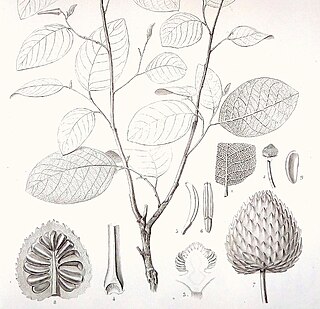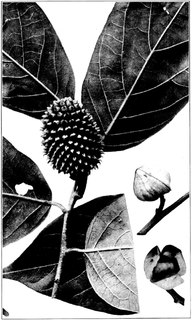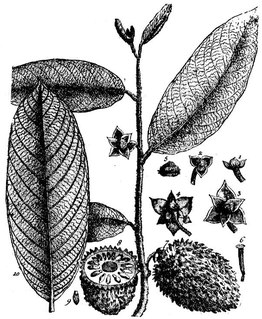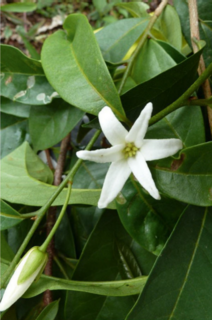
Annona sericea is a species of plant in the family Annonaceae. It is native to Bolivia, Brazil, Colombia, French Guiana, Guyana, Suriname, Trinidad-Tobago and Venezuela. Michel Félix Dunal, the French botanist who first formally described the species, named it after the silky hairs on its branches and leaves. In Brazil its common name is Aratincum do Para.
Annona acutiflora is a species of plant in the Annonaceae family. It is native to Brazil. Carl Friedrich Philipp von Martius, the German botanist who first formally described the species, named it after the inner petals which come to a sharp point.

Annona bullata is a species of plant in the family Annonaceae. It is native to Cuba. Achille Richard, the French botanist who first formally described the species, named it after the bubbled appearance of the spaces between the fine network of veins in the leaves.

Annona crassivenia is a species of plant in the family Annonaceae. It is native to Cuba. William Edwin Safford, the American botanist who first formally described the species, named it after the thick tertiary veins that interconnect the secondary veins of its leaves.

Annona jahnii is a species of plant in the family Annonaceae. It is native to the Brazil, Colombia and Venezuela. William Edwin Safford, the American botanist who first formally described the species, named it after the Venezuelan scientist, explorer and mountain climber Alfredo Jahn.

Annona paludosa is a species of plant in the family Annonaceae. It is native to Brazil, French Guiana, Guyana, Suriname and Venezuela. Jean Baptiste Christophore Fusée Aublet, the French pharmacist and botanist who first formally described the species, named it after its swampy habitat.
Annona stenophylla is a species of plant in the family Annonaceae. It is native to Tanzania and Zambia. Adolf Engler and Ludwig Diels, the German botanists who first formally described the species, named it after its narrow leaves.

Cremastosperma cauliflorum is a species of plant in the family Annonaceae. It is native to Brazil, Colombia, Ecuador and Peru. Robert Elias Fries, the Swedish botanist who first formally described the species, named it after its flowers which grow from its main trunk or stem.
Goniothalamus elegans is a species of plant in the family Annonaceae. It is native to Thailand and Vietnam. Suzanne Jovet-Ast, the French botanist who first formally described the species, named it after its elegant thin, flexible leaves.

Goniothalamus giganteus is a species of plant in the family Annonaceae. It is native to Malaya, Myanmar, Sumatra and Thailand. Joseph Dalton Hooker and Thomas Thomson, the British botanists who first formally described the species, named it after its exceptionally large flowers.
Goniothalamus tamirensis is a species of plant in the family Annonaceae. It is native to Cambodia, Laos, Peninsular Malaysia, Thailand and Vietnam. The French botanists J.B. Louis Pierre and François Gagnepain, who first formally described the species, named it after the region in Cambodia it was collected from, which they record as “monts Tamir”.

Hexalobus crispiflorus is a species of plant in the family Annonaceae. It is native to Angola, Benin, Cameroon, Central African Republic, Congo, DR Congo, Gabon, Ghana, Guinea, Guinea-Bissau, Ivory Coast, Liberia, Nigeria, Senegal, Sierra Leone, Sudan, Togo and Zaire. Achille Richard, the French botanist who first formally described the species, named it after its wavy petals of its flowers.
Mitrephora alba is a species of plant in the family Annonaceae. It is native to Peninsular Malaysia. Henry Nicholas Ridley, the English botanist who first formally described the species, named it after its white flowers.

Mitrephora maingayi is a species of plant in the family Annonaceae. It is native to Bangladesh, Borneo, Cambodia, Laos, Peninsular Malaysia, Myanmar, Sumatra, and Vietnam. Joseph Hooker and Thomas Thomson, the British botanists who first formally described the species, named it in honor of Alexander Carroll Maingay, the British botanist who collected the specimen they examined.

Mischogyne elliotiana is a species of plant in the Annonaceae family. It is native to Cameroon, Gabon, Ghana, Guinea-Bissau, Ivory Coast, Liberia, Nigeria, Sierra Leone, and Zaire. Adolf Engler and Ludwig Diels, the German botanists who first formally described the species using the basionym Uvaria elliotiana, named it after George Scott-Elliot the botanist who collected the specimen they examined.

Neostenanthera myristicifolia is a species of plant in the family Annonaceae. It is native to Benin, Cameroon, The Central African Republic, The Democratic Republic of the Congo, Equatorial Guinea, Gabon, Nigeria, and The Republic of the Congo.
Pseuduvaria costata is a species of plant in the family Annonaceae. It is native to New Guinea. Rudolph Scheffer, the Dutch botanist who first formally described the species using the basionym Orophea costata, named it after its prominently ribbed fruit.

Pseuduvaria latifolia is a species of plant in the family Annonaceae. It is native to Java. Carl Ludwig Blume, the German botanists who first formally described the species using the synonym Bocagea latifolia, named it after its broad leaves.
Pseuduvaria mollis is a species of plant in the family Annonaceae. It is native to New Guinea. Otto Warburg, the German-Jewish botanists who first formally described the species using the basionym Goniothalamus mollis, named it after the soft hairs on its leaves and petals.

Annona cherimolioides is a species of plant in the Annonaceae family. It is native to Colombia and Ecuador. José Jerónimo Triana and Jules Émile Planchon, the botanists who first formally described the species, named it after its resemblance to another Annona species A. cherimoya.













